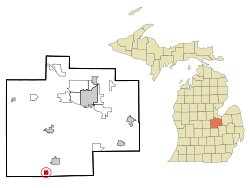Oakley, Michigan
| Oakley, Michigan | |
|---|---|
| Village | |
 Location of Oakley, Michigan |
|
| Coordinates: 43°8′29″N 84°10′8″W / 43.14139°N 84.16889°W | |
| Country | United States |
| State | Michigan |
| County | Saginaw |
| Area | |
| • Total | 1.03 sq mi (2.67 km2) |
| • Land | 1.02 sq mi (2.64 km2) |
| • Water | 0.01 sq mi (0.03 km2) |
| Elevation | 679 ft (207 m) |
| Population (2010) | |
| • Total | 290 |
| • Estimate (2016) | 276 |
| • Density | 280/sq mi (110/km2) |
| Time zone | Eastern (EST) (UTC-5) |
| • Summer (DST) | EDT (UTC-4) |
| ZIP code | 48649 |
| Area code(s) | 989 |
| FIPS code | 26-59860 |
| GNIS feature ID | 0633890 |
Oakley is a village in Saginaw County in the U.S. state of Michigan. The population was 290 at the 2010 census. The village is within Brady Township, although about half of the village would lie within Chesaning Township on the east, if the boundary line had not been adjusted.
Originally the area was called Mickleville. Philip Mickle, who owned a tavern there in 1842, became the first postmaster of Mickleville on March 12, 1856. That post office was moved to the hamlet of Havana on April 18, 1860, which was two miles southeast of Oakleys present location. In 1868, Andrew Huggins plotted and recorded the village of Oakley and the post office was moved from Havana. It was named for Judge Oakley of Dutchess County, New York, a relative of one of its citizens. Oakley was incorporated as a village in 1887.
In 1880 Oakley had a population of 350, one school, three dry-goods stores, two grocers, two drug stores and two hardware stores. It had a factory that employed 40 people.
According to the United States Census Bureau, the village has a total area of 1.03 square miles (2.67 km2), of which, 1.02 square miles (2.64 km2) of it is land and 0.01 square miles (0.03 km2) is water.
As of the census of 2010, there were 290 people, 116 households, and 76 families residing in the village. The population density was 284.3 inhabitants per square mile (109.8/km2). There were 135 housing units at an average density of 132.4 per square mile (51.1/km2). The racial makeup of the village was 95.2% White, 3.8% African American, 0.7% Native American, and 0.3% from two or more races. Hispanic or Latino of any race were 3.8% of the population.
...
Wikipedia
